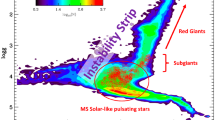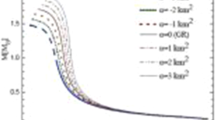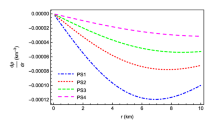Abstract
Proper elements are quasi-integrals of motion of a dynamical system, meaning that they can be considered constant over a certain timespan, and they permit to describe the long-term evolution of the system with a few parameters. Near-Earth objects (NEOs) generally have a large eccentricity, and therefore they can cross the orbits of the planets. Moreover, some of them are known to be currently in a mean-motion resonance with a planet. Thus, the methods previously used for the computation of main-belt asteroid proper elements are not appropriate for such objects. In this paper, we introduce a technique for the computation of proper elements of planet-crossing asteroids that are in a mean-motion resonance with a planet. First, we numerically average the Hamiltonian over the fast angles while keeping all the resonant terms, and we describe how to continue a solution beyond orbit-crossing singularities. Proper elements are then extracted by a frequency analysis of the averaged orbit-crossing solutions. We give proper elements of some known resonant NEOs and provide comparisons with non-resonant models. These examples show that it is necessary to take into account the effect of the resonance for the computation of accurate proper elements.










Similar content being viewed by others
Data Availability
The datasets generated during and/or analyzed during the current study are available from the corresponding author on reasonable request.
Notes
Note that \(\omega _p\) and \(\Omega _p\) are ill-defined because the planets move on circular and zero-inclination orbits; hence, we identify \(\lambda _p\) with \(\ell _p\).
Equation (2.5) for \(\sigma \) is used for the purpose of definition, but since all resonant harmonics are kept in the Hamiltonian, this method describes all types of \(h_p\):h resonances at once (i.e., with a different combination of \(\Omega ,\Omega _p, \varpi , \varpi _p\) fulfilling the D’Alembert rules)
Here, the subscript h is used to refer to a local minimum point, it has nothing to do with the integer of the resonant combination of Eq. (2.5).
References
Bottke, W.F., et al.: Debiased orbital and absolute magnitude distribution of the Near-Earth objects. Icarus 156(2), 399–433 (2002)
Brouwer, D.: Secular variations of the orbital elements of minor planets. Astron. J. 56, 9 (1951)
Carpino, M., et al.: Long-term numerical integrations and synthetic theories for the motion of the outer planets. Astron. Astrophys. 181(1), 182–194 (1987)
de la Fuente Marcos, C., de la Fuente Marcos, R.: Asteroid (469219) 2016 HO\(_{3}\), the smallest and closest Earth quasi-satellite. Mon. Not. R. Astron. Soc. 462(4), 3441–3456 (2016)
Everhart, E.: An efficient integrator that uses Gauss–Radau spacings. In: Carusi, A., Valsecchi, G.B. (eds.) IAU Colloq. 83: Dynamics of Comets: Their Origin and Evolution, vol. 115, p. 185. Springer, Berlin (1985)
Fenucci, M., Novaković, B.: The role of the Yarkovsky effect in the long-term dynamics of asteroid (469219) Kamo’oalewa. Astron. J. 162(6), 227 (2021)
Gallardo, T.: Atlas of the mean motion resonances in the Solar System. Astron. J. 184(1), 29–38 (2006)
Gastineau, M., Laskar, J.: TRIP: a computer algebra system dedicated to celestial mechanics and perturbation series. ACM Commun. Comput. Algebra 44(3/4), 194–197 (2011)
Granvik, M., et al.: Escape of asteroids from the main belt. Astron. Astrophys. 598, A52 (2017)
Gronchi, G.F.: An algebraic method to compute the critical points of the distance function between two Keplerian orbits. Celest. Mech. Dyn. Astron. 93(1–4), 295–329 (2005)
Gronchi, G.F., Milani, A.: Averaging on Earth-crossing orbits. Celest. Mech. Dyn. Astron. 71(2), 109–136 (1998)
Gronchi, G.F., Michel, P.: Secular orbital evolution, proper elements, and proper frequencies for Near-Earth asteroids: a comparison between semianalytic theory and numerical integrations. Icarus 152(1), 48–57 (2001)
Gronchi, G.F., Milani, A.: Proper elements for Earth-crossing asteroids. Icarus 152(1), 58–69 (2001)
Gronchi, G.F., Tommei, G.: On the uncertainty of the minimal distance between two confocal keplerian orbits. Discrete Contin. Dyn. Syst. B 7(4), 755–778 (2007)
Gronchi, G.F., Tardioli, C.: The evolution of the orbit distance in the double averaged restricted 3-body problem with crossing singularities. Discrete Contin. Dyn. Syst. B 18, 1323 (2013)
Hairer, E., et al.: Geometric Numerical Integration: Structure-Preserving Algorithms for Ordinary Differential Equations. Springer Series in Computational Mathematics, vol. 31, 2nd edn. Springer, Berlin (2002)
Henrard, J.: Expositions in Dynamical Systems, volume 2 of Dynamics Reported. Springer, Berlin (1993)
Henrard, J., Lemaitre, A.: A perturbative treatment of the 2/1 Jovian resonance. Icarus 69(2), 266–279 (1987)
Hirayama, K.: Groups of asteroids probably of common origin. Astron. J. 31, 185–188 (1918)
Hirayama, K.: Families of asteroids. Jpn. J. Astron. Geophys. 1, 55 (1922)
Jones, R.L., et al.: Asteroid discovery and characterization with the large synoptic survey telescope. In: Chesley, S.R., et al. (eds.) Asteroids: New Observations, New Models, vol. 318, pp. 282–292 (2016)
Knežević, Z.: Asteroid family identification: history and state of the art. In: Chesley, S.R., et al. (eds.) Asteroids: New Observations, New Models, vol. 318, pp. 16–27 (2016)
Knežević, Z., Milani, A.: Synthetic proper elements for outer main belt asteroids. Celest. Mech. Dyn. Astron. 78, 17–46 (2000)
Knežević, Z., Milani, A.: Proper element catalogs and asteroid families. Astron. Astrophys. 403, 1165–1173 (2003)
Knežević, Z., et al.: The determination of asteroid proper elements. In: Bottke, W.F., et al. (eds.) Asteroids III, pp. 603–612. University of Arizona Press, Tucson (2002)
Kozai, Y.: Secular perturbations of asteroids with high inclination and eccentricity. Astron. J. 67, 591–598 (1962)
Kozai, Y.: The dynamical evolution of the Hirayama family. In: Gehrels, T., Matthews, M. (eds.) Asteroids, pp. 334–358. University of Arizona Press, Tucson (1979)
Kozai, Y.: Secular perturbations of resonant asteroids. Celest. Mech. 36(1), 47–69 (1985)
Laskar, J.: Secular evolution of the Solar System over 10 million years. Astron. Astrophys. 198(1–2), 341–362 (1988)
Laskar, J.: The chaotic motion of the solar system: a numerical estimate of the size of the chaotic zones. Icarus 88(2), 266–291 (1990)
Laskar, J., et al.: The measure of chaos by the numerical analysis of the fundamental frequencies. Application to the standard mapping. Phys. D 56(2–3), 253–269 (1992)
Laskar, J.: Frequency map analysis and quasiperiodic decompositions. In: Benest, D, et al. (eds.) Hamiltonian Systems and Fourier Analysis: New Prospects for Gravitational Dynamics, pp. 99–134. Cambridge Scientific Pub, Cambridge (2005)
Lemaitre, A., Morbidelli, A.: Prober elements for highly inclined asteroidal orbits. Celest. Mech. Dyn. Astron. 60(1), 29–56 (1994)
Marò, S., Gronchi, G.F.: Long term dynamics for the restricted \(N\)-body problem with mean motion resonances and crossing singularities. SIAM J. Appl. Dyn. Syst. 17(2), 1786–1815 (2018)
Michel, P., Froeschlé, C.: The location of linear secular resonances for semimajor axes smaller than 2 AU. Icarus 128(1), 230–240 (1997)
Milani, A., Knežević, Z.: Secular perturbation theory and computation of asteroid proper elements. Celest. Mech. Dyn. Astron. 49(4), 347–411 (1990)
Milani, A., Knežević, Z.: Asteroid proper elements and secular resonances. Icarus 98(2), 211–232 (1992)
Milani, A., Knežević, Z.: Asteroid proper elements and the dynamical structure of the asteroid main belt. Icarus 107(2), 219–254 (1994)
Milani, A., Baccili, S.: Dynamics of Earth-crossing asteroids: the protected Toro orbits. Celest. Mech. Dyn. Astron. 71(1), 35–53 (1998)
Milani, A., et al.: Asteroid families classification: exploiting very large datasets. Icarus 239, 46–73 (2014)
Moons, M., Morbidelli, A.: Secular resonances inside mean-motion commensurabilities: the 4/1, 3/1, 5/2 and 7/3 cases. Icarus 114(1), 33–50 (1995)
Namouni, F.: Secular interactions of coorbiting objects. Icarus 137(2), 293–314 (1999)
Neishtadt, A.: On the change in the adiabatic invariant on crossing a separatrix in systems with two degrees of freedom. J. Appl. Math. Mech. 51(5), 586–592 (1987)
Nesvorný, D., et al.: Identification and dynamical properties of asteroid families. In: Michel, P., et al. (eds.) Asteroids IV, pp. 297–321. University of Arizona Press, Tucson (2015)
Novaković, B., Radović, V.: Asteroid families portal. In: EPSC-DPS Joint Meeting 2019, vol. 2019, pp. EPSC–DPS2019–1671 (2019)
Saillenfest, M., Lari, G.: The long-term evolution of known resonant trans-Neptunian objects. Astron. Astrophys. 603, A79 (2017)
Saillenfest, M., et al.: Long-term dynamics beyond Neptune: secular models to study the regular motions. Celest. Mech. Dyn. Astron. 126(4), 369–403 (2016)
Saillenfest, M., et al.: Study and application of the resonant secular dynamics beyond Neptune. Celest. Mech. Dyn. Astron. 127(4), 477–504 (2017)
Schunová, E., et al.: Searching for the first near-Earth object family. Icarus 220(2), 1050–1063 (2012)
Sidorenko, V.V.: Evolution of asteroid orbits at the 3:1 their mean motion resonance with Jupiter (planar problem). Cosm. Res. 44(5), 440–455 (2006)
Sidorenko, V.V.: The eccentric Kozai–Lidov effect as a resonance phenomenon. Celest. Mech. Dyn. Astron. 130(1), 4 (2018)
Sidorenko, V.V.: A perturbative treatment of the retrograde co-orbital motion. Astron. J. 160(6), 257 (2020)
Sidorenko, V.V., et al.: Quasi-satellite orbits in the general context of dynamics in the 1:1 mean motion resonance: perturbative treatment. Celest. Mech. Dyn. Astron. 120(2), 131–162 (2014)
Spoto, F., et al.: Asteroid family ages. Icarus 257, 275–289 (2015)
Venigalla, C., et al.: Near-Earth asteroid characterization and observation (NEACO) mission to asteroid (469219) 2016 HO3. J. Spacecr. Rocket 56(4), 1121–1136 (2019)
Vokrouhlický, D., et al.: Yarkovsky/YORP chronology of asteroid families. Icarus 182(1), 118–142 (2006)
Williams, J.G.: Secular Perturbations in the Solar System. PhD thesis, University of California (1969)
Williams, J.G.: Proper elements and family memberships of the asteroids. In: Gehrels, T., Matthews, M. (eds.) Asteroids, pp. 1040–1063. University of Arizona Press, Tucson (1979)
Williams, J.G.: Asteroid family identifications and proper elements. In: Binzel, R.P., et al. (eds.) Asteroids II, pp. 1034–1072. University of Arizona Press, Tucson (1989)
Wisdom, J.: A perturbative treatment of motion near the 3/1 commensurability. Icarus 63(2), 272–289 (1985)
Acknowledgements
We thank the anonymous referee for the comments and suggestions that helped us to improve the manuscript. MF and GFG have been supported by the H2020 MSCA ETN Stardust-Reloaded, grant agreement number 813644. GFG also acknowledges the project MIUR-PRIN 20178CJA2B “New frontiers of Celestial Mechanics: theory and applications” and the GNFM-INdAM (Gruppo Nazionale per la Fisica Matematica).
Author information
Authors and Affiliations
Corresponding author
Additional information
Publisher's Note
Springer Nature remains neutral with regard to jurisdictional claims in published maps and institutional affiliations.
This article is part of the topical collection on Dynamics of Space Debris and NEO.
Guest Editors: Xiyun Hou, Massimiliano Vasile and Alessandra Celletti.
Crossing singularity
Crossing singularity
1.1 The minimum orbit intersection distance
Let \((E, \ell ), (E', \ell ') \in \mathbb {R}^6\) be two sets of orbital elements of two Keplerian orbits with a common focus. The components \(E, E' \in \mathbb {R}^5\) describe the shape of the orbit, while \(\ell , \ell ' \in S^1\) are the mean anomalies. We denote with \(\mathcal {E}= (E,E') \in \mathbb {R}^{10}\) the couple of the orbit configurations, and with \(V = (\ell ,\ell ') \in \mathbb {T}^2 = S^1 \times S^1\) the parameters along the orbits. We choose a reference frame centered at the common focus and we denote with \(\mathcal {X}(E,\ell ), \mathcal {X}'(E', \ell ')\) the Cartesian coordinates of the two bodies. For a given configuration \(\mathcal {E}\), we define the Keplerian distance function d as
Let \(V_h=V_h(\mathcal {E})\) be a local minimum pointFootnote 9 of the Keplerian distance function and consider the maps
A configuration \(\mathcal {E}\) is non-degenerate if all the critical points of the Keplerian distance function are non-degenerate. If \(\mathcal {E}\) is non-degenerate, then there exists a neighborhood \(\mathcal {W}\subseteq \mathbb {R}^{10}\) of \(\mathcal {E}\) such that the maps \(d_h\), restricted to \(\mathcal {W}\), do not have bifurcations.
The functions \(d_h\) and \(d_{\text {min}}\) are not smooth at crossing configurations, and their derivatives do not exist. However, it is possible to define analytical maps in a neighborhood of a non-degenerate crossing configuration \(\mathcal {E}_c\) by choosing an appropriate sign for the maps. We summarize the procedure to deal with the crossing singularity of \(d_h\), the procedure for \(d_{\text {min}}\) being the same. We consider the points on the two ellipses corresponding to the local minimum points \(V_h = (\ell _h, \ell '_h)\) of \(d^2\), i.e.,
We denote with \(\tau _h, \tau '_h\) the tangent vectors to the trajectories \(E,E'\) at these points, i.e.,
and their cross-product
We define also \(\Delta = \mathcal {X}-\mathcal {X}', \Delta _h = \mathcal {X}_h-\mathcal {X}'_h\). The vector \(\Delta _h\) joins the points attaining a local minimum value of \(d^2\), hence \(|\Delta _h|=d_h\). From the definition of critical points of \(d^2\), both vectors \(\tau _h, \tau '_h\) are orthogonal to \(\Delta _h\), therefore \(\tau ^*_h\) and \(\Delta _h\) are parallel. Denoting with \(\widehat{\tau }^*_h,\widehat{\Delta }_h\) the corresponding unit vectors, the distance with sign
is an analytic function in a neighborhood of a crossing configuration, provided that \(\tau _h\) and \(\tau '_h\) are not parallel, situation happening only when the trajectories are tangent at the crossing point (Gronchi and Tommei 2007). The derivatives of \(\tilde{d}_h\) with respect to the component \(\mathcal {E}_k, \, k=1,\dots ,10\) of \(\mathcal {E}\) are given by
1.2 Extraction of the singularity
Denote by \(\mathcal {E}_c\) a non-degenerate crossing configuration with only one crossing point. We choose the index h such that \(d_h(\mathcal {E}_c) = 0\). For each \(\mathcal {E}\) in a neighborhood of \(\mathcal {E}_c\), we consider the Taylor development of \(V\mapsto d^2(\mathcal{E},V) = |\mathcal {X}-\mathcal {X}'|^2\), in a neighborhood of the local minimum point \(V_h=V_h(\mathcal {E})\), i.e.,
where
is the Hessian matrix of \(d^2\) at \(V_h=(\ell _h,\ell _h')\), and \(\mathcal{R}^{(h)}\) is the Taylor remainder. We introduce the approximated distance
where
and
If the matrix \(\mathcal {A}_h\) is non-degenerate, then it is positive definite since \(V_h\) is a minimum point, and this property holds in a suitably chosen neighborhood \(\mathcal {W}\) of \(\mathcal {E}_c\). The matrix \(\mathcal {A}_h\) is degenerate at the crossing configuration if and only if the tangent vectors \(\tau _h,\tau _h'\) are parallel; therefore, in the following, we always assume that the crossing is not tangent.
To extract the singularity at an orbit crossing, we split the integral as
Let us set \(\mathcal {S} = \{ \mathcal {E}\in \mathcal {W}: \, d_h(\mathcal {E})=0 \}\), and denote with \(y_k \in \{ \Sigma , U, V, \sigma , u, v \}\) one of the coordinates. The derivatives of the first term in the right-hand side of Eq. (A.13) are integrable, and the map
can be extended continuously to the whole set \(\mathcal {W}\). To compute the derivatives in Eq. (A.14), we can use
From Eq. (A.8), we obtain the derivatives of the approximated distance as
The derivatives of \(V_h\) are computed by differentiating the relation
which holds since \((\mathcal {E}, V_h(\mathcal {E}))\) is a stationary point of \(d^2\). Hence,
Note that the derivatives of 1/d are obtained with standard computations, and they can be expressed through the derivatives of the position of the asteroid with respect to the Delaunay variables. On the other hand, the average over \(\mathbb {T}^2\) of the derivatives of \(1/\delta _h\) is non-convergent integrals for \(\mathcal {E}\in \mathcal {S}\) and contains the main part of the singularity of the vector field.
1.3 Integration of \(1/\delta _h\) and its derivatives
Let \((\mathcal {E}_c, V_h(\mathcal {E}_c))\) be a crossing configuration. We consider the transformations
where \(\sqrt{\mathcal {A}_h}\) is defined as the unique positive definite matrix such that \((\sqrt{\mathcal {A}_h})^2 = \mathcal{A}_h\). With these constraints, the entries \(a_{ij}\) of \(\sqrt{\mathcal {A}_h}\) are
where \(\alpha = \sqrt{\det \mathcal {A}_h}\), and \(A_{ij}\) are the entries of \(\mathcal {A}_h\). Using these transformations to change the coordinates in the integral, we get
where
Let us consider the points \(P_1 \equiv (\pi ,\pi ), P_2 \equiv (-\pi ,\pi ), P_3 \equiv (-\pi ,-\pi ), P_4 \equiv (\pi ,-\pi )\) and their images \(Q_j \equiv (x_j,y_j), j=1,\dots ,4\) through \(\mathcal{L}_h\), so that
Set \(P_5=P_1\) and, for \(j=1,\ldots ,4\), let \(\mathscr {R}_j\) be the straight line passing through the points \(P_j, P_{j+1}\), i.e.,
where \(\xi _j = x_{j+1}-x_j, \ \eta _j = y_{j+1}-y_j.\) Introducing polar coordinates \((\rho ,\theta )\) such that \(W = (\rho \cos \theta , \rho \sin \theta )\), we can write these lines in polar form
with
and
Note that
so that, for each \(j=1,\ldots ,4\),
and
With these changes of coordinates, Eq. (A.21) becomes
with
and
The integrals in Eq. (A.34) are bounded; hence, they are differentiable functions of the elements. On the contrary, the term \(-2\pi d_h/\sqrt{\det \mathcal{A}_h}\) is not differentiable at \(\mathcal {E}= \mathcal {E}_c\in \mathcal {S}\), and the loss of regularity is due only to this term. The derivatives of Eq. (A.34) with respect to \(y_k \in \{ \Sigma , U, V, \sigma , u,v \}\) can be computed by exchanging the integral sign and the derivative, i.e.,
The term \(-2\pi d_h/\sqrt{\det {\mathcal {A}_h}}\) is not differentiable at the orbit crossing; however, the derivatives admit two analytic extensions \((\frac{\partial \mathcal {K}_{\text {sec}}}{\partial y_k})_h^{\pm }\) on \(\mathcal {W}^+ = \mathcal {W}\cap \{\tilde{d}_h > 0\}\) and \(\mathcal {W}^- = \mathcal {W}\cap \{\tilde{d}_h < 0\}\), where \(\mathcal{W}\) is a neighborhood of the crossing configuration \(\mathcal{E}_c\) where \(\tilde{d}_h\) is defined, and \(\mathcal{A}_h\) is non-degenerate (Gronchi and Tardioli 2013). Moreover, the jump in the derivatives passing from \(\mathcal {W}^+\) to \(\mathcal {W}^-\) is given by
Rights and permissions
About this article
Cite this article
Fenucci, M., Gronchi, G.F. & Saillenfest, M. Proper elements for resonant planet-crossing asteroids. Celest Mech Dyn Astron 134, 23 (2022). https://doi.org/10.1007/s10569-022-10078-4
Received:
Revised:
Accepted:
Published:
DOI: https://doi.org/10.1007/s10569-022-10078-4




